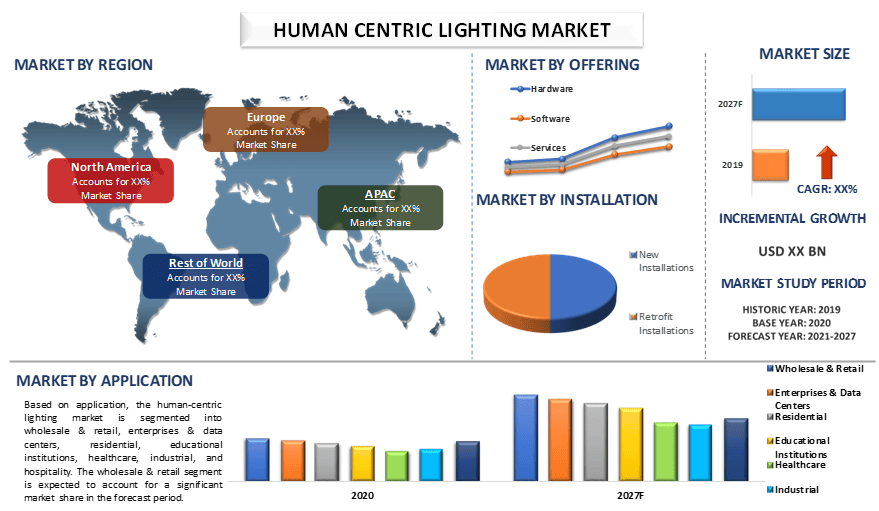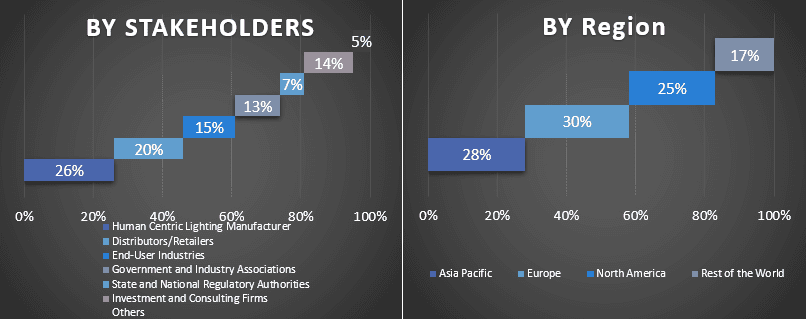- Home
- About Us
- Industry
- Services
- Reading
- Contact Us
Human Centric Lighting Market: Current Analysis and Forecast (2021-2027)
Emphasis on Offering (Hardware (Fixtures, Controllers), Software, and Services), By Installation (New Installations and Retrofit Installations), By Application (Wholesale & Retail, Enterprises & Data Centers, Residential, Educational Institutions, Healthcare, Industrial, And Hospitality); and Region/Country

The Human Centric Lighting market demand is increasing at an influential rate over the years and is expected to witness extensive growth during the forecasted period as well. As working conditions have a powerful effect on the health of individuals and bad lighting had a significant impact on productivity, errors, health problems, absenteeism, accidents, staff motivation, and retention rate. Moreover, factors that are positively impacting the market size of human-centric lighting are increasing demand for energy-efficient lighting systems in various sectors, including residential, commercial, retail, hospitality, and public infrastructure is driving the human-centric lighting industry expansion.
In addition, LEDs and various tunable fixtures used in these systems consume less power compared to conventional halogen & incandescent lamps, enhancing the adoption of these systems. Along with energy efficiency features, these lights also offer compatibility with circadian rhythms and lower harmful impacts on visual & non-visual health.
The global Human centric lighting market is expected to register a CAGR of around 5 % throughout 2021-2027. Human Centric Lighting is a lighting concept that provides light appropriate to the user’s living or working conditions. It’s the right light for the time of day and the season. Light has various effects, and it always works – visually, emotionally, and biologically. Human Centric Lighting (HCL) has a specific long-term effect on our health, well-being, and productivity any human being through holistic planning and implementation of the visual, emotional, and particularly biological impacts of light. Human Centric Lighting provides a basis to create the best possible interplay between artificial light and natural daylight, providing light that makes humans the focus of attention. Moreover, various factors such as the increase in the need for energy-efficient lighting, high development of smart lighting systems, and high usage of LED lighting solutions, drive the human-centric lighting market growth. However, high installation and maintenance cost is expected to hinder the global market growth. In addition, the rising adoption of wireless technology for lighting systems is expected to create opportunities for the human-centric lighting industry.
Signify Lighting NV, OSRAM AG, Acuity Brands, Inc., Cree, Inc., Legrand SA, Hubbell Inc., Lutron, Electronics Co., Inc., Zumtobel Group AG, Philips NV, Wipro Enterprises Ltd are some of the key players in the market. Several M&As along with partnerships have been undertaken by these players to facilitate customers with hi-tech and innovative products/technologies.
Insights Presented in the Report
“Offering, hardware segment accounted for the majority share in the market in 2020”
Based on the offering, the human-centric lighting market is classified into hardware (fixtures, controllers), software, and services. The hardware segment caters to extensive market share in the human-centric lighting market. Hardware components, such as controllers & fixtures, are witnessing a high demand owing to visual benefits and technical advancements.
“Amongst installation, retrofit installation segment is expected to witness highest CAGR during the forecast period”
Based on the installation, the human-centric lighting market is bifurcated into new installations and retrofit installations. The retrofit installation segment acquired a considerable market share in the human-centric lighting market. It is mainly due to the rising consumer awareness regarding the importance of having adequate illumination. Lighting systems may create different psychological effects on customers working in the commercial sector.
“Based on application, wholesale and retail segment expected to witness extensive CAGR during the forecast period”
Based on application, the human-centric lighting market is segmented into wholesale & retail, enterprises & data centers, residential, educational institutions, healthcare, industrial, and hospitality. The wholesale & retail segment is expected to account for a significant market share in the forecast period. Commercial sites such as banks, retail stores, and restaurants are likely to contribute significantly to the segmental growth during the assessment timeframe. Adoption of these systems in such places facilitates a healthy sleep-wake cycle among employees that helps in retaining focus by providing a cool blue light in the morning.
“Europe to witness significant growth during the forecast period”
Europe is expected to hold a significant market share in the forecast period owing to the growing installation of smart light systems in healthcare and commercial segments. Healthcare facilities and elderly care residences are implementing body dynamic lighting solutions to provide better environments and gain health-related benefits, enhancing the market representation. Moreover, growing government focus and initiatives related to the provision of enhanced workplace facilities and a patient-friendly & comfortable atmosphere are propelling the market size of human-centric lighting in the region.
For instance, in 2020, Europe had started the “EU Renovation Wave Initiative” which states that there should be no renovation without an upgrade of lighting installations. This EU building policy and initiatives help to address both energy efficiency and indoor environmental quality (IEQ) for occupants.
Reasons to buy this report:
- The study includes market sizing and forecasting analysis validated by authenticated key industry experts.
- The report presents a quick review of overall industry performance at one glance.
- The report covers an in-depth analysis of prominent industry peers with a primary focus on key business financials, product portfolios, expansion strategies, and recent developments.
- Detailed examination of drivers, restraints, key trends, and opportunities prevailing in the industry.
- The study comprehensively covers the market across different segments.
- Deep dive regional level analysis of the industry.
Customization Options:
Global Human centric lighting market can further be customized as per the requirement or any other market segment. Besides this, UMI understands that you may have your own business needs, hence feel free to connect with us to get a report that completely suits your requirements.
Table of Content
Research Methodology for the Global Human Centric Lighting Market Analysis (2021-2027)
Analyzing the historical market, estimating the current market, and forecasting the future market of the global human-centric lighting market were the three major steps undertaken to create and analyze the adoption of human-centric lighting in major regions globally. Exhaustive secondary research was conducted to collect the historical market numbers and estimate the current market size. Secondly, to validate these insights, numerous findings and assumptions were taken into consideration. Moreover, exhaustive primary interviews were also conducted, with industry experts across the value chain of the global human-centric lighting market. Post assumption and validation of market numbers through primary interviews, we employed a top-down/bottom-up approach to forecasting the complete market size. Thereafter, market breakdown and data triangulation methods were adopted to estimate and analyze the market size of segments and sub-segments of the industry pertains to. Detailed methodology is explained below:
Seek More Details About Research Methodology
Analysis of Historical Market Size
Step 1: In-Depth Study of Secondary Sources:
Detail secondary study was conducted to obtain the historical market size of the human centric lighting market through company internal sources such as annual reports & financial statements, performance presentations, press releases, etc., and external sources including journals, news & articles, government publications, competitor publications, sector reports, third-party database, and other credible publications.
Step 2: Market Segmentation:
After obtaining the historical market size of the human centric lighting market, we conducted a detailed secondary analysis to gather historical market insights and share for different segments & sub-segments for major regions. Major segments are included in the report as offering, installation, and application. Further country-level analyses were conducted to evaluate the overall adoption of testing models in that region.
Step 3: Factor Analysis:
After acquiring the historical market size of different segments and sub-segments, we conducted a detailed factor analysis to estimate the current market size of the human centric lighting market. Further, we conducted factor analysis using dependent and independent variables such as various offerings, installation, and applications of the human centric lighting. A thorough analysis was conducted for demand and supply-side scenarios considering top partnerships, mergers and acquisitions, business expansion, and product launches in the Human centric lighting market sector across the globe.
Current Market Size Estimate & Forecast
Current Market Sizing: Based on actionable insights from the above 3 steps, we arrived at the current market size, key players in the global human centric lighting market, and market shares of the segments. All the required percentage shares split, and market breakdowns were determined using the above-mentioned secondary approach and were verified through primary interviews.
Estimation & Forecasting: For market estimation and forecast, weights were assigned to different factors including drivers & trends, restraints, and opportunities available for the stakeholders. After analyzing these factors, relevant forecasting techniques i.e., the top-down/bottom-up approach were applied to arrive at the market forecast about 2027 for different segments and sub-segments across the major markets globally. The research methodology adopted to estimate the market size encompasses:
- The industry’s market size, in terms of revenue (USD) and the adoption rate of the human centric lighting market across the major markets domestically
- All percentage shares, splits, and breakdowns of market segments and sub-segments
- Key players in the global human centric lighting market in terms of services offered. Also, the growth strategies adopted by these players to compete in the fast-growing market
Market Size and Share Validation
Primary Research: In-depth interviews were conducted with the Key Opinion Leaders (KOLs) including Top Level Executives (CXO/VPs, Sales Head, Marketing Head, Operational Head, Regional Head, Country Head, etc.) across major regions. Primary research findings were then summarized, and statistical analysis was performed to prove the stated hypothesis. Inputs from primary research were consolidated with secondary findings, hence turning information into actionable insights.
Split of Primary Participants in Different Regions

Market Engineering
The data triangulation technique was employed to complete the overall market estimation and to arrive at precise statistical numbers for each segment and sub-segment of the global human centric lighting market. Data was split into several segments & sub-segments post studying various parameters and trends in the areas of offering, installation, and application in the global human centric lighting market.
The main objective of the Global Human Centric Lighting Market Study
The current & future market trends of the global human centric lighting market were pinpointed in the study. Investors can gain strategic insights to base their discretion for investments on the qualitative and quantitative analysis performed in the study. Current and future market trends determined the overall attractiveness of the market at a regional level, providing a platform for the industrial participant to exploit the untapped market to benefit from a first-mover advantage. Other quantitative goals of the studies include:
- Analyze the current and forecast market size of the human centric lighting market in terms of value (USD). Also, analyze the current and forecast market size of different segments and sub-segments
- Segments in the study include areas of offering, installation, and application.
- Define and analysis of the regulatory framework for the human centric lighting market industry.
- Analyze the value chain involved with the presence of various intermediaries, along with analyzing customer and competitor behaviors of the industry.
- Analyze the current and forecast market size of the human centric lighting market for the major region.
- Major countries of regions studied in the report include Asia Pacific, Europe, North America, and the Rest of the world.
- Company profiles of the human centric lighting market and the growth strategies adopted by the market players to sustain in the fast-growing market
- Deep dive regional level analysis of the industry
Related Reports
Customers who bought this item also bought










